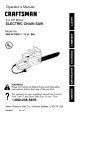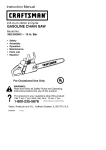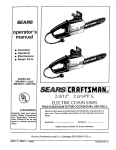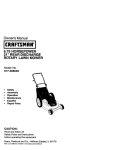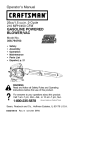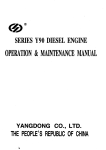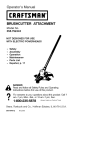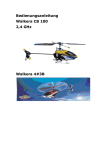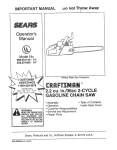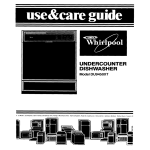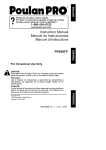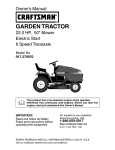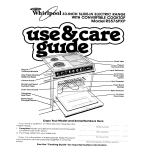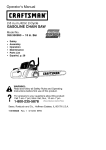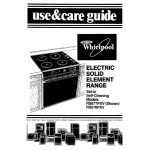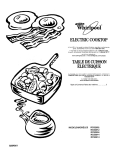Download Poulan 1975 Chainsaw User Manual
Transcript
Poulan
Por
favor,
el aparato
al lugar de compra.
Please
do no
not devuelva
return unit
to retailer.
Veuillez ne pas retourner I'outil au d_taillant.
•
1-800-554-6723
www.poulan.com
Instruction Manual
Manual de Instrucciones
Manuel d'lnstructions
1950 / 1975 / 2050 / 2055 / 2075
2150 / 2155 / 2175 / 2350 / 2375
2050WT / 2150PR
For Occasional
&
Use Only
WARNING:
Read and follow all Safety Rules and Operating Instructions before
using this product. Failure to do so can result in serious injury.
ADVERTENCIA:
Lea et manual de instrucciones y siga todas Ias advertencias e enstrucciones de seguridad. Et no hacerlo puede resuItar en tesiones
graves.
AVERTISSEMENT:
Lire le manuel d'instructions
et bien respecter tous tes avertissemerits et toutes tes instructions de s_curit& Tout defaut de le faire
pourrait entra_ner des blessures graves.
Poulan
t030 Stevens Creek Road
Augusta, GA 30907
Poulan
5855 Terry Fox Way
Mississauga, Qntario L5V 3E4
545186768
Rev. 1
4/15/08
BRW
----_
Read and understand
the
instruction
manuaI before
using the chain saw.
saw can be dangerous! Careless or improper use can cause
WARNING!
This chain
serious or even fatal injury
w
Measured
maximum
kickback value
without
chain
brake for the bar and chain
combination on the label
Always wear appropriate ear
protection,
eye protection
and head protection.
i
@
A_ways use two hands when operating
the chain saw.
WARNING!
Contacting the guide bar tip with any object
should be avoided; tip contact may cause the guide bar to
move suddenly upward and backward, which may cause serious injury.
Starting
Fleminder
Move ON/STOP
a
_
Prime aX
(_)_
Full Choke
--
Pull 5X
switch to
the ON position.
Slowly press primer bulb
6 times.
Half
Pull choke/fast
Choke
idle lever
outtothe
fu,extent
{to
the PULL CHOKE
tion)
_ll WARNING:
Always
posi-
disconnect
spark pIug wire and place wire where it cannot contact spark plug to prevent accidental
starting when setting up, transporting,
adjusting or making repairs except carburetor
adjustments.
Because a chain saw is a high-speed woodcutting toef, speciaI safety precautions must
be observed to reduce the risk of accidents.
Careless or improper use of this toef can
CaUSe SeRous Enlui'y
PLAN AHEAD
• Read this manuef carefully until you completely understand and can follow efl safety
rules, precautions, and operating instructions before attempting to use the unit.
PUll to Statl
Pul_ the starter rope
sharply 5 times with your
right hand.
Push the choke/fast idle
lever in to the HALF
CHOKE position.
Pull the starter rope sharply
with your right hand un_l
the engine stairs.
• Restdct the use of your saw to adult users
who understand
and can follow safety
rules, precautions,
and operating instructions found in this manual.
• Wear protective gear. Always use steeF
toed safety footwear with non-slip soles;
snug-fitting clothing; heavy-duty, non-slip
gloves; eye protection such as non-fogging, vented goggles or face screen; an
approved safety hard hat; and sound barriers (ear plugs or mufflers) to protect your
hearing. Regular users should have hearing checked regularly as chain saw noise
can damage hearing. Secure hair above
shou*der Iength.
Hearing
Safety
Hat
Protection
_Jj
Eye
"'"_ i _i_ _" Protection
Snug
Fitting
"-----._
Heavy
Duty
Clothing,_plP_l_c/GIoves
Safety_1_Safety
Chaps
• Keep
allparts
ofyour
body
away
from
the
chain
when
theengine
isrunning.
• Keep
children,
bystanders,
and
animals
a
minimum
of30feet
(10meters)
away
from
the
work
area.
Do
not
al}ow
other
people
oranimals
tobenear
thechain
saw
when
starting
oroperating
thechain
saw.
• Donothandle
oroperate
achain
saw
when
you
arefatigued,
ill,orupset,
orifyouhave
taken
alcohol,
drugs,
ormedication.
You
must
beingood
physical
condition
and
mentatly
aIed.
Chain
saw
work
isstrenuous.
If
you
have
any
condition
that
might
beaggravated
bystrenuous
work.
check
w_th
your
doctor
before
operaflng
achain
saw.
• Carefully
plan
your
sawing
operation
inadvance.
Donotstart
cutting
unfll
youhave
a
clear
work
area,
secu
refooting,
and,
ifyou
arefelling
trees,
aplanned
retreat
path.
OPERATE
YOUR
SAW SAFELY
• Do not operate a chain saw with one hand.
Serious injury to the operator, helpers, bystanders or any combination of these persons may result from one-handed operation.
A chain
saw
ts intended for
two-handed use
• Operate the chain saw only in a weII-ventilatad outdoor area.
• Do not operate saw from a ladder or in a tree.
• Make sure the chain wilt not make contact
with any object while starting the engine.
Never try to start the saw when the guide
bar is in a cut.
• Do not put pressure on the saw at the end of
the cut. Applying pressure can cause you to
lose controt when the cut is completed.
• Stop the engine before setting the saw
down.
• Do not operate a chain saw that is damaged, improperly
adjusted, or not completaly and securely assembled.
Always
replace bar, chain, hand guard, or chain
brake immediately if it becomes damaged,
broken or is otherwise removed.
• With the engine stopped, hand carry the
chain saw with the muffler away from your
body, and the guide bar and chain to the
rear, preferably covered with a scabbard.
MAINTAIN
YOUR
SAW
IN GOOD
WORKING
ORDER
• Have aII chain saw service performed by a
qualified service dealer with the exception
of the items listed in the maintenance sac-
tion of this ma_uaL For example, if improper tools are used to remove or hold the flywheel when servicing the clutch, structural
damage to the flywheel can occur and
cause the flywheel to burst.
• Make certain the saw chain stops moving
when the throttle trigger is released.
For
correction, refer to CARBURETOR
ADJUSTMENTS
• Never modify your saw in any way
• Keep the handles dry, clean, and free of oil
or fuel mixture.
• Keep fuel and oil caps, screws, and fasteners securely tightened.
• Use only PouIan
accessorfes
and replacement parts as recommended.
HANDLE
FUEL WITH CAUTION
• Do not smoke while handIing fuel or while
operating the saw.
• Eliminate all sources of sparks or flame in
the areas where fuel is mixed or poured.
There should be no s rooking, open flames,
or work that could cause sparks. Allow engine to cool before refueling.
• Mix and pour fuel in an outdoor area on
bare ground; store fuel in a cool, dry, we_l
ventilated place; and use an approved,
marked container for all fuel purposes.
Wipe up all fuel spills before starting saw
• Move at least 10 feet (3 meters) from fueling site before starting engine.
• Turn the engine off and let saw cool in a
non-combustible
area, not on dry leaves,
straw, paper, etc Slowly remove fuel cap
and refuel unit.
• Store the unit and fueHn an area where fuel
vapors cannot reach sparks
or open
flames from water heaters, electric motors
or switches, fumaces, etc.
KICKBACK
ji_ WARNING:
Avoid kickback
which
can result in serious injury. Kickback is the
backward, upward or sudden forward motion
of the guide bar occurdng when the saw
chain near the upper tip of the guide bar contacts any object such as a log or branch, or
when the wood closes in and pinches the
saw chain in the cut. Contacting a foreign object in the wood can also result in loss of
chain saw control.
• Rotational
Kickback can occur when the
moving chain contacts an object at the upper tip of the guide bar. This contact can
cause the chain to dig into the object,
which stops the chain for an instant. The
result is a lightning fast, reverse reaction
which kicks the guide bar up and back toward the operator.
• Pinch-Kickback
can occur when the the
wood closes in and pinches the moving
saw chain in the cut aIong the top of the
guide bar and the saw chain is suddenly
stopped. This sudden stopping
of the
chain results in a reversa_ of the chain
force used to cut wood and causes the
saw to move in the opposite direction of the
chain rotation. The saw is driven straight
back toward the operator.
• Pull-In
can occur when the moving chain
contacts a foreign object in the wood in the
cut along the bottom of the guide bar and the
saw chain is suddenly stopped. This sudden
stopping pulls the saw forward and away
from the operator and could easily cause the
operator to lose controt of the saw
Avoid Pinch-Kickback:
• Be extremely aware of situations or obstructions that can cause material to pinch
the top of or otherwise stop the chain.
• Do not cut more than one log at a time.
• Do not twist the saw as the bar is withdrawn from an undercut when bucking
Avoid Pull-In:
• Always begin cutting with the engine at full
speed and the saw housing against wood.
• Use wedges
made of pIastic or wood.
Never use metal to hold the cut open
• Use the Reduced-Kickback Guide Bar
and Low-Kickback Chain specified for
your saw
MAINTAIN CONTROL
Stand to the
left of the saw
,_
underside of
handlebar
_ Thumb
on
Never
hand positions
Thumb on underside
handlebar
Ctear The Working Area
REDUCE
THE CHANCE
OF
KICKBACK
• Recognize
that kickback
can happen.
With a basic understanding
of kickback,
you can reduce the element of surprise
which contributes to accidents.
• Never let the moving chain contact any object at the tip of the guide bar
• Keep the working area free from obstructions such as other trees, branches, rocks,
fences, stumps, etc Eliminate or avoid
any obstruction that your saw chain could
hit while you are cutting
When cutting a
branch, do not let the guide bar contact
branch or other objects around it.
• Keep your saw chain sharp and properly
tensioned.
A loose or dull chain can increase the chance of kickback occurring.
Follow manufacturer's
chain sharpening
and maintenance instructions.
Check tension at reguIar intervals with the engine
stopped, never with the engine running.
Make sure the chain brake nuts are securely tightened after tensioning the chain.
• Seginandcontinuecutfingatfullspeed
If
the chain is moving at a slower speed,
there is greater chance of kickback occurring.
• Cut one log at a time.
• Use extreme caution when re-entering a
previous cut.
• Do not attempt cuts starting with the tip of
the bar (plunge cuts).
• Watch for shifting logs or other forces that
could close a cut and pinch or fall into
chain.
of
• Keep a good, firm grip on the saw with both
hands when the engine is running and don't
let go. A firm grip will help you reduce kickback and maintain control of the saw. Keep
the fingers of your left hand encircling and
your left thumb under the ftont handlebar.
Keep your dght hand completely around the
rear handle whether your are right handed or
left handed. Keep your left arm straight with
the elbow locked.
• Position your left hand on the front handlebar so it is in a straight line with your right
hand on the rear handle when making
bucking cuts. Never reverse right and left
hand positions for any type of cutting.
• Standwithyourweightevenly
balancedon
both feet.
• Stand slighfiy to the Ieft side of the saw to
keep your body from being in a direct line
with the cutting chain.
• Do not overreach.
You could be drawn or
thrown off balance and lose control of the
saw
• Donotcutaboveshoutderheight.
Itisdifficult to maintain
control of saw above
shoulder height
KICKBACK
SAFETY
FEATURES
_
WARNING:
Thefollowingfeatures
are included on your saw to help reduce the
hazard of kickback; however, such features
will not totally e}iminate this danger.
As a
chain saw user, do not rely only on safety devices.
You must follow eli safety precautions, instructions,
and maintenance
in this
manual to hetp avoid kickback and other
forces which can result in serious injury
• Reduced-Kickback
Guide
Bar,
designed dnI_W/-_I-(NIN£_:
,tt _____._A
with
asmall
radius
tipwhich
reduces
the
RESENT AND
sizeofthekickback
danger
zone on the
bar tip. A Reduced-Kickback
Guide Bar
has been demonstrated
to significantly reduce the number and seriousness of kickbecks when tested in accordance
with
safety requirements for gasoline powered
chain saws as set by ANSI B175.1
ReducedKickback SymrnetricalGuide Bar
all RadiusTip
Symrnetrica_
Guide
Bar
_.,._
Large
Radius
Tip
• Low-Kickback
Chain, designed
with a
contoured
depth gauge and guard link
which dedect kickback force and allow
wood to gradually ride into the cutter LowKickback Chain has met kickback performance requirements when tested on a
representative
sample of chain saws below 3.8 cubic inch displacement
specified
in ANSi B175.1
WE DO NOT REPYOU SHOULD
NOT ASSUME THAT THE CHAIN BRAKE WILL
PROTECT YOU IN THE EVENT OFA KICKBACK.
Kickback is a lightning fast action
which throws the bar and rotating chain back
and up toward the operator. Kickback can be
caused by allowing contact of the bar tip in tile
danger zone wifh any hard object
Kickback
can also be caused by pinching the saw chain
along the top of the guide baE This action may
push the guide bar rapidly back toward the operator. Either of these events may cause you
to lose control of the saw which could result in
serious injury or even death. DO NOT RELY
UPON ANY OF THE DEVICES BUILT INTO
YOUR SAW. YOU SHOULD USE THE SAW
PROPERLY AND CAREFULLY TO AVOID
KICKBACK.
Reduced-kickback
guide bars
and low-kickback
sew chains reduce the
chance and magnitude of kickback and are
recommended.
Your saw has a low kickback
chain and bar as original equipment. Repairs
on a chain brake should be made by an authorized servicing dealer. Take your unit to the
place of purchase if purchased from a servicing dealer, or to the nearest authorized master
service dealer.
• _p contact in some cases may cause a lightning fast reverse REACTION, kicking guide
bar up end back toward operator.
• Pinching the saw chain along the top of the
guide bar may push the guide bar rapidly
back toward the operator
• Either of these reactions may cause you to
lose control of the saw which could result in
serious injury. Do not rely excIusively upon
devices buiif into your saw.
,_ WARNING:
Chain
to gradualJy ride
_ntocutter
%
_ _X
N_
a LOW
Kickback
_C an ObstructMatelial
Chain
• Front Hand Guard, designed to reduce the
chance of your Ieft hand contacting the chain
if your hand slips off the front handlebar.
• Position of front and rear handlebars, designed with distance between handles and
'ingJne" with each other. The spread and
"in-line" position of the hands provided by
this design work together to give balance
end resistance in controlling the pivot of
the saw back toward the operator if kickback occurs.
CHAIN
BRAKE
AND
• Chain Brake, designed
the event of kickback.
CKA ANGLE
to stop the chain in
Computed
kickback
angle (CKA) listedon your saw and listed in the
CKA table below represents angle of kickback
your bar and chain combinations will have
when tested in accordance with CSA (Canadian Standards Association) and ANSI standards. When purchasing replacement bar and
chain, considerations should be given to the
lower CKA values Lower CKA values represent safer angles to the user. higher values indicate more angle and higher kick energies
Computed angles represented indicate total
energy and angle associated without activation
of the chain brake during kickback Activated
angle represents chain stopping time relative to
activation angle of chain break and resulting
kick angle of saw. in all cases lower CKA values represent a safer operaffng environment
for the user.
The following guide bar and chain combinations meet kickback requirements of CSA
Standards Z62.f, Z62.3. & ANSI B175.1 when
used on saws listed in this manual Use of bar
and chain combinations other than those listed
is not recommended and may not meet the
OKA requirements per standard.
Computed
kickback
MODEL
1950/1975/
2050/2050WT
2055/2075/
2150/215OPR
2155/2175/
2350/2375
angle
BAR
P/N
(CKA
Table
CKA without chain brake
Length
CHAIN P/N
952044368
14"
952051209
24
952044370
16"
952051211
19'
952044418
18"
952051338
14
NOTE:
If this saw is to be used for commercial logging, a chain brake is required
and shatl not be removed or otherwise disab+ed to comply with Federal OBHA Regulations for Commercial
Logging.
_kWARNING:
The engine exhaust
from this product contains chemicals known
to the State of California to cause cancer,
birth defects or other reproductive harm.
SAFETY
NOTICE:
Exposure to vibrations
through prolonged use of gasoline powered
hand tools couid cause blood vesse_ or nerve
damage in the fingers, hands, and joints of
beagle prone to circulation
disorders
or
abnormal swe}lings. Prolonged use in cold
weather has been tinked to blood vessel
damage
in otherwise
healthy
people. If
symptoms occur such as numbness, pain,
loss of strength, change in skin color or texture,
or loss of feeling in the fingers, hands, or joints,
disconbnue the use of this too+ and seek
medicat attention. An anti-vibration system
does not guarantee the avoidance of these
problems. Users who operate power toots on
a continua+ and regular basis must monitor
closely their
physical cond+tion and the
cond_on of this tool
SPECIAL
NOTICE:
Your saw is equipped
with a temperature liming muffler and spark
arresbng
screen
which
meets
the
requirements of California Codes 4442 and
4443. All U.S. forest land and the states of
California+ Idaho, Maine, Minnesota,
New
Jersey, Oregon, and Washington require by
faw that many internal combustion engines to
be equipped with a spark arresting screen if
you operate a chain saw in a state or locale
where such regulations exist, you are legally
responsibte
for maintaining
the operating
cond_on of these parts. Failure to do so is a
victet_on of the law. Refer to the SERVICE
section for maintenance of the spark arresting
screen. Fd+iure to follow all Safety Rules and
Precautions can result in serious injury. If
situations occur which are not covered in this
manual, use care and good judgement, ff you
need assistance,
contact your authorized
service dealer or cali t-800-554-6723.
STANDARDS:
This saw is listed by Underwriter's Laboratories, inc., in accordance with:
ANSi
B175.1-2000
American
National
Standards
for Gasoline-Powered
Chain
Saws - Safety Requirements
CSA Z62.1-03 Chain Saws - Occupabenal
Health and Safety
CSA Z62.g-96 Chain Saw Kickback Occupational Health and Safety
Protective gloves (not provided)
worn during assembly
ATTACHING
TH E BAR
already attached)
WARNING:
should
&CHAIN
be
(If not
if received assembled,
repeat all steps to ensure your saw is properly
assembled and all fasteners are secure. Always wear gloves when handling the chain.
The chain is sharp and can cut you even when
is not moving!
1. Loosen and remove the chain brake
nuts and the chain brake from the saw.
2
Remove the pIastic shipping spacer (if
present).
Location of shipping spacer
Ch
Nuts
a_
3.
Chain
Brake
Bar Tool
An adjusting pin and screw Ls used to adjust the tens+on of the cha+n It is very important when assembling the bar, that the
pin facated on the adjusting screw aligns
into a hole in the bar. Turning the screw will
move the adjustment pin up and down the
screw. Locate this adjustment before you
begin mounting the bar onto the saw. See
il:ustration below.
Adjustment facated on Chain Brake
4. Turn the adjusting screw by hand counterclockwise
untii the adjusting pin just
touches the stop. This should allow the
pin to be near the correct position.
5
Slide guide bar behind c+utoh drum until
guide bar stops against crutch drum
sprocket.
Fro_ 1_
_LAI_
ED
_
"__-_:J!
6. Carefully
remove
thechain
from
thepackage.Hold
chain
w_thedrive
links as
GAGED
ii_"
shown.
/
DIIRECTiON
OF ROTATION
Drive
Unks
_.
Chain Brake Nuts
Place
chain
onto
the
sprocket
7.
Place chain over and behind efutch, fitting the dnve ]inks in the clutch drum
sprocket.
8. Fit bottom of drive links between the
teeth in the sprocket in the nose of the
guide bar.
g. Fit chain drive links into bar groove.
10. Pu]I guide bar forward until chain is snug
in guide bar groove
Ensure all drive
_inks are in the bar groove
NOTE:
CHAIN BRAKE MUST BE
DISENGAGED
BEFORE INSTALLATION ON THE SAW. TO DISENGAG E
CHAIN BRAKE, PULL THE FRONT
HAND GUARD BACK TOWARD THE
REAR OF THE CHAIN BRAKE AS
FAR AS POSSIBLE (SEE ILLUSTRATION).
Ghatn Brake
11. Now, install chain brake making sure the
adjusting pin is positioned in the lower
hole in the guide bar Remember this pin
moves the bar forward and backward as
the screw is turned.
12 Install chain brake nuts and finger tighten only. Once the chain is tensioned,
you will need to tighten chain brake nuts
CHAIN
TENSION
(Including units with chain already installed)
NOTE:
When adjusting chain tension,
make sure the chain brake nuts are finger
tight onIy. Attempting to tension the chain
when the chain brake nuts are tight can
cause damage.
Checking
the teneion:
Use the screwdriver end of the chain adjustment tool (bar tool) to move the chain around
the bar. tf the chain does not rotate, _ is too
tight. If too loose, the chain will sag below the
bar
Tool (Bar Tool)
Adjueting
the tension:
Chain tension is very important.
Chain
stretches during use. This is especially true
during the first few times you use your saw
Always check chain tension each time you
use and refuel your saw.
You can adjust the chain tension by loosening the chain brake nuts and turning the adjusting screw 1/4 of a turn while lifting up on
the ban
• If chain is too tight, turn adjusting screw t/4
turn counterclockwise.
• If chain is too loose, turn adjusting screw
t/4 turn clockwise.
f'-_
LL_tJ, /
_
Adju sting
O
Chain Brake Nuts
/
/
Screw
Guide Bar
Adjusting Screw - 1/4 Turn
Chain Brake
• Lift up the tip of the bar and tighten
chain brake nuts with the bar tool.
• Recheck chain tension.
the
_Nuts
.
_,WARNING:
if the saw is operated
with a loose chain, the chain could jump off
the guide bar and result in serious injury.
KNOW YOUR CHAIN SAW
READ THIS INSTRUCTION
MANUAL AND SAFETY RULES BEFORE OPERATING
YOUR
CHAIN SAW Compare the illustrations with your unit to familiarize yourself with the location of
the various contrefs and adjustments. Save this manual for future reference.
Chain
Adjustment Tool
(Bar Tool)
Front Hand Guard "_-
Front Handle
Starter Rope
ON/STOP
Switch
Chain
Muffler
Primer
M
Bar Oit Fill Cap
Cylinder
Housing
Fuel Mix Fill Cap
Cover
_
Lockout _
Rear Throttle
\ _ttiet
Handle
o
_
s%1 Sw,,ng
'_
Throttle
Trigger
Choke/
Fast idle
Lever
ON/STOP
SWITCH
The ON/STOP SWITCH
engine
Chain
Brake
Chain
Catcher
fr#a°
Chain Brake
'
Nuts
Bar Sprocket
is used to stop the
THRO'FrLE
TRIGGER
Time THROlqLE
TRIGGER
speed.
Chain
controls engine
THRO'FrLE
LOCK-OUT
Time THRO]q-LE
LOCK-OUT
must be
pressed before you can squeeze the throttle
thgger. This feature prevents you from accidentally squeezing the trigger.
CHOKE/FAST
IDLE LEVER
The choke and fast idle are set by pulIing the
CHOKE/FAST IDLE LEVER out to the falI ex-
Hefe
tent for cold staring or after refueling. The
choke provides additional fuef to the engine
during cefd staring.
PRIMER
BULB
The PRIMER BULB circulates fuel to tile carburefor to prowde quicker starting.
CHAIN
BRAKE
The CHAIN BRAKE is a device designed to
stop the chain if kickback occurs. The chain
brake activates automatically in the event of
kickback. The chain brake activates manually
if the front hand guard is pushed forward. The
chain brake is disengaged by pulling the front
hand guard back toward the front handle as far
as possible.
CHAIN
TENSION
It is normal for a new chain to stretch during the
first 15 minutes of operation. You should check
your chain tension ftequentiy. See CHAIN
TENSION under the ASSEMBLY section.
FUELING
_i_ WARNING:
Muffler is very hot during and after use. Do not touch the muffler or
allow combustible
matedal such as dry
grass or fuel to do so
system of an engine while in storage
To
avoid engine problems,
the fuel system
should be emptied before storage for 30
days or longer. Drain the gas tank, start the
engine and let it run until the fuel lines and
carburetor are empty.
Use fresh fuef next
season.
See STORAGE section for additional information.
ENGINE
_k WARNING:
ly when refueling.
Remove fuel cap s_ow-
I_kWAHNIN(3:
The chain must not
move when the engine runs at idle speed. If
the chain moves at idle speed refer to CARBURETOR
ADJUSTMENT
within
this
manual. Avoid contact with the muffler. A hot
muffler can cause serious burns
To stop the engine move the ON/STOP
switch to the STOP position.
To start the engine hold the saw firmly on
the ground as illustrated
Make sure the
chain is free to turn without contacting any
object
Use only 15" - 18" (38 - 45 cm) of
rope per pull
Hold saw firmly while pul_ing starter rope.
Starter Rope Handle
This engine is certified to operate on unleaded
gasoline. Before operation, gasoline must be
mixed with a good quality synthetic 2-cycle aircooled engine oit designed to be mixed at a ratioof4O:l
Poulan&'VEED EATER brandsynthetic oil is recommended.
A 40:1 ratio is
obtained by mixing 3.2 ounces (95 ml) of oil
with 1 gallon (4- liters) of unleaded gasefine. Included with this saw is a 3.2 ounce container of
PoulanfWEED
EATER brand synthetic
oil.
Pour the entire content_ of this container into f
gallon of gasoline to achieve the proper fuel
mixture. DO NOT USE automotive or marine
oil. These oils will cause engine damage.
When mixing fuef feflow the instructions
printed on the container. Always read and
follow the safety rules listed under HANDLE
FUEL WITH CAUTION
BAR AND CHAIN
LUBRICATION
The bar and chain require continuous lubrication.
Lubrication is provided by the automatic oiler system when the oil tank is kept
filled. Lack of oil will quickly ruin the bar and
chain. Too little oil will cause overheating
shown by smoke coming from the chain and/
or discoloration of the bar.
In freezing weather oil will thicken, making it
necessary
to thin bar and chain oii with a
small amount (5 to 10%) of # 1 Diesel Fuel or
kerosene
Bar and chain oil must be free
flowing for the oil system to pump enough oiI
for adequate lubdcedon.
Genuine Poulan bar and chain oil is recommended to protect your unit against excessive wear from heat and fedtion. Poulan
oil
resists high temperature thinning.
If PouIan
bar and chain oil is not available,
use a good grade SAE 30 oil
• Never use waste oil for bar and chain lubbcation
• Always stop the engine before removing
the oil cap.
IMPORTANT
Experience indicates that a_cohef-blended
fuels (called gasohot or using ethanol or
methanol) can attract moisture which leads
to separation and formation of acids during
storage.
Acidic gas can damage the fuel
Right Foot Through Rear Handle
IMPORTANT
POINTS TO REMEMBER
When pulling the starter rope, do not use the
full extent of the rope as this can cause the
rope to break. Do not let starter rope snap
back
Hold the handle and let the rope rewind slowly.
For cold weather starting, start the unit at
FULL CHOKE: allow the engine to warm up
before squeezing the throttle trigger.
NOTE:
Do not attempt to cut matebal with
the choke/fast idle lever in the FULL CHOKE
position.
STARTING
A COLD
ENGINE
(or
warm engine after running out of
fuel)
9
CHAIN
NOTE:
h_ the following steps, when the
choke/fast idle lever is pulled out to the full
extent, the correct throttle setting for starting
is set automatically.
ON/STOP SWITCH
(SIDE VIEW)
_
BRAKE
_I, WARNING:
tf the brake
band is
worn too thin it may break when the chain
brake is triggered With a broken brake band,
the chain brake will not stop the chain The
chain brake should be replaced by an authorized service dealer if any part is worn to less
than O O2O" (05 mm) thick. Repairs on a
chain brake should be made by an authorized service dealer Take your unit to the
place of purchase if purchased from a servicing dealer, or to the nearest authorized
master service dealer.
• This saw is equipped with a chain brake
The brake is designed to stop the chain if
kickback occurs
• The
inertia-activated
chain
brake
is
activated if the front hand guard is pushed
forward,
either manually
(by hand) or
automatically (by sudden movement)
• If the brake is already
activated,
it is
disengaged by pulling the front hand guard
back toward the front handle as far as
possible
• When cutting with the saw, the chain brake
must be disengaged
STOP
ON
1.
Move ON/STOP switch to the ON position.
Slowly press primer bulb 6 times
Pult choke/fast
idle lever out to the full
extent (to the FULL CHOKE position)
4. Pulithe starter rope sharply 5 times with
your nght hand. Then, proceed to the
next step.
NOTE:
If the engine sounds as if it is trying
to start before the 5th putl, stop pulling and
immediately proceed to the next step.
5. Push the choke/fast idle lever in to the
HALF CHOKE
osition.
CHOKE/FA_T
IDLE LEVER
2.
3.
o_EW)
Ch
fast idle lever
OFF
HALF
FULL
8. Pul} the starter rope sharp}y with your
right hand until the engine starts
7. Altow the engine to run for approximateIy 30 seconds
Then, squeeze and retease the throttle trigger to allow engine
to return to idle speed
STARTING
A WARM
ENGINE
1. Move ON/STOP switch to the ON position
2. Slowly press primer bulb 6 times.
3. Puli the choke/fast idle lever out to the
HALF CHOKE position.
4-. Pull the starter rope sharply with your
right hand unfl_ the engine starts.
5. Squeeze and release throttle trigger to
allow engine to return to idle speed.
DIFFICULT
STARTING
(or 8tarring
a
flooded
engine)
The engine may be flooded with too much
fuel if it has not started after fO pulls.
Flooded engines can be cleared of excess
fuel by pushing the choke/fast idle lever in
completely
(to the OFF CHOKE position)
and then following the warm engine starting
procedure
listed above. Ensure the ON/
STOP sw_tch is in the ON position.
Starting could require pulling the starter rope
handle many times depending on how badly
the unit is flooded. If engine fails to start, refer
to the TROUBLESHOOTING
TABLE or call
1-800-554-6723.
Braking
function
control
CAUTION:
The chain brake must be
checked
several times daily. The engine
must be running when performing this procedure. This is the only instance when the saw
should be placed on the ground with the engine runmng.
Place the saw on firm ground Grip the rear
hand}e with your right hand and the front handle with your left hand. Apply full throttle by
fuily depressing the throttle trigger. Activate
the chain brake by turning your left wrist
against the hand guard without releasing
your grip around the front handle The chain
should stop immediately
Inertia
activating
_WARNING:
function
control
When performing the
following procedure,
the engine must be
turned off
G rip the rear handle with your right hand and
the front handle with your left hand. Hold the
chain saw approximately
14" (35 cm) above
a stump or other wooden surface
Release
your grip on the front handle and use the
weight of the saw to let the tip of the guide bar
fall forward and contact the stump. When the
tip of the bar hits the stump, the brake should
activate
10
sloping terrain. Use a plumb or level to determine the dLrection of tree Lean.
• Weight and branches on one side.
• Surrounding trees and obstacles
Look for decay and rot. if the trunk is rotted,
it can snap and fall toward the operator
Check for broken or dead branches which
can fall on you while cutting.
Make sure there is enough room for the tree
to fail.
Maintain a distance
of 2 1/2 tree
lengths from the nearest person or other objects Engine noise can drown out a warning
caLL Remove dirt, stones, loose bark, nails,
staples, and wire from the tree where cuts
are to be made Plan a clear retreat path to
the rear and diagonal to the line of fall.
IMPORTANT
POINTS
• Check chain tension before first use and
after f minute of operation.
See CHAIN
TENSION Lnthe ASSEMBLY
section
• Cut wood only. Do not cut metal, plastics,
masonry, non-wood building materials, etc.
• Stop the saw ff the chain strikes a foreign
object. Lnspect the saw and repair or replace parts as necessary.
• Keep the chain out of dirt and sand Even a
small amount of dirt will quickly dult a chain
and thus increase the possibil*ty of kickback.
• Practice cutting a few small logs using the
foIIowing techniques to get the "feeF of using your saw before you begin a major
sawing operation.
• Squeeze the throftle trigger and allow
the engine to reach full speed before
cutting.
• Begin cutting
with the saw frame
against the log.
• Keep the engine at full speed the entire
time you are cutting.
• ALlow the chain to cut for you. Exert only
light downward pressure.
If you force
the cut, damage to the bar, chain, or engine can result.
• Release the throttle trigger as soon as
the cut is completed, allowing the engine to idle. If you run the saw at full
throttle without a cutting Load, unnecessary wear can occur to the chain, bar,
and engine
• To avoid tosing conttoL when cut is complete, do not put pressure on saw at end
of cut.
• Stop the engine before setting the saw
down after cutting.
TREE
FELLING
WARNING:
_x_ e
_"- _ - O'''"_
FELLtNG
LARGE
- Direction
path
of Fall
TREES
(6 inches (t5 cm) in diameter or Iarger)
The notch method is used to fell large trees.
A notch is cut on the side of the tree in the desired direction of fal_ After a felling cut is
made on the opposite side of tree, the tree
will tend to fall into the notch
NOTE:
If the tree has large buttress roots,
remove them before making the notch, ff using saw to remove buttress roots, keep saw
chain from contacting ground to prevent dulling of the chain.
NOTCH
CUT AND FELLING
THE
TREE
• Make notch cut by cutting the top of the
notch first. Cut through 1/3 of the diameter
of the tree. Next complete the notch by cutting the bottom of the notch. See i_lusttation. Once the notch is cut remove the
notch of wood from the tree
Final (felling) cut here, 2 inches
(5 cm) above center of notch
TECHNIQUES
Check for broken
Plan a clear retreat
or
dead branches which can fall wMle cutting
causing serious injury. Do not cut near buildings or etecthcal wires if you do not know the
direction of tree fall, nor cut at night since you
will not be ale to see welt, nor during bad
weather such as rain. snow, or strong winds,
etc. if the tree makes contact with any utility
line, the utility company should be notified
immediately.
• CarefuLly plan your sawing operation in advance.
• Cleartheworkarea
Youneedacleararea
alI around the tree so you can have secure
footing.
• The chain saw operator should keep on
the uphLtl side of the terrain as the tree is
likely to rolI or slide downhill after it is relied.
• Study the naturat conditions that can cause
the tree to falI in a particular direction.
Natural conditions that can cause a tree to
falI in a particular direction include:
• The wind direction and speed.
• The lean of the tree. The lean of a tree
might not be apparent due to uneven or
First cut \.._1
..._2 ,___
i'
Notch
Second
_
... J..
2-
cut
• After removing the wood from the notch,
make the felling cut on the opposite side of
the notch. This is done by making a cut about
two inches (5 cm) higher than the center of
the notch. This will leave enough uncut wood
between the felling cut and the notch to form
a hinge. This hinge will help prevent the tree
from fal_ing in the wrong direction
11
Hinge holds tree on stump and helps
control fall
Opening
of felling
use a metalwedge.
Do not attempt to restart
your saw when it is pinched or hung in a log.
Use a wedge
to remove
pinched
saw
Turn saw OFF and use a plastic or
wooden wedge to force cut open
Closing
notch
Overcutgng
begins on the top side of the log
with the bottom of the saw against the log
When overcutfiog
use _ight downward pressure.
of
NOTE:
Before felling cut is complete, use
wedges
to open the cut ff necessary
to
control the direction of fall. To avoid kickback
and chain damage,
use wood or plastic
wedges, but never steel or iron wedges.
• Be alert to signs that the tree is ready to
fall: cracking sounds, widening of the felling cut. or movement
in the upper
branches.
• As tree starts to fall, stop saw, put it down,
and get away quickty on your planned retreat path
• DO NOT cut down a partially failen tree with
your saw. Be extremely caubeus with parflally fallen trees that may be beody supported. When a tree doesn't falI completely,
set the saw aside and pull down the tree with
a cable winch, block and tackle, or tractor
CUTTING
A FALLEN
_WARNING:
a fallen
Do not stand on thelog
being cut Any portion can roll causing loss
of footing and control. Do not stand downhil_
of the log being cut.
IMPORTANT
POINTS
Second cut
Second cut
• CUt onty one log at a time.
• Cut shattered wood very carefully; sharp
pieces of wood could be flung toward operatoe
• Use a sawhorse to cut smaII Iogs. Never
allow another person to hold the log while
cutting and never hold the log with your leg
or foot.
• Do not cut in an area where logs, limbs,
and roots are tangled such as in a blown
down area. Drag the logs into a clear area
before cutting by pulliog out exposed and
cleared logs first.
TYPES
OF CUTTING
BUCKING
AqLWARNING:
Neverturnsawogside
down to undercut. The saw cannot be controlled in this position.
Always make your first cut on the compression side of the log. The compression side of
the log is where the pressure of the log's
weight is concentrated.
First cut on compression
side of Iog
TREE
(BUCKING)
Bucking is the term used for cutting
tree to the desired log size
A4_WARNING:
Undercutting
involves cutting on the underside of the log with top of saw against the log.
When undercutting
use light upward pressure. Hold saw firmty and maintain control
The saw will tend to push back toward you.
USED
If saw
First cut on compression
side of log
BUCKING
WITHOUT
A SUPPORT
• Overcut through 1/3 of the diameter of the
log.
• Roll the log over and finish with a second
overcut.
• Watch for logs with a compression side to
prevent the saw from pinching. Bee ilIustrabens for cutting logs with a compression side.
BUCKING
USING A LOG OR
SUPPORT
STAND
• Remember your first cut is always on the
compression side of the log.
(Refer to the illustraflons below for your
first and second cut)
• Your first cut should extend 1/3 of the
diameter of the log.
• Finish with your second cut.
FOR
becomes
pinched or hung in a log, don't try to force it
out. You can Iose control of the saw res ulting
in injury and/or damage to the saw. Stop the
saw, drive a wedge of plasfic or wood into the
cut untiI the saw can be removed easiIy. Restart the saw and carefully reenter the cut. To
avoid kickback and chain damage, do not
12
Using
LIMBING
• AIwayslimbatreeafferitiscutdown
Only
then can limbing be done safely and propedy.
• Leave the larger limbs underneath the felled
tree to support the tree as you work.
• Start at the base of the failed tree and work
toward the top, cutting branches and Iimbs
Remove small limbs with one cut.
• Keep the tree between you and the chain.
Cut from the side of the free opposite the
branch you are cutting
• Remove larger, suppor_ng branches with
the cutting techniques described in SUCKiNG WITHOUT A SUPPORT
• Always use an overcut to cut small and freeiy hanging limbs. Undercu_ing could cause
limbs to fal} and pinch the saw.
PRUNING
a log for support
2 r_dCut
1 st Cut
2 _ Cut
Using a support
_'P"2_
stand
_&WARNING:
L
/
L
LIMBING
Umit pruning to limbs
shoulder height or below.
Do not cut if
branches are h_gher than your shoulder. Get a
professional to do the job.
• Make your first cut b3 of the way through the
bottom of the limb.
• Next make a 2nd cut all the way through
the limb. Then cut a third overc ut leaving a
t to 2 inch (2 5 to 5 cm) collar from thetruck
of the tree
2 nd Cut
AND
PRUNING
Second
cut
Third cxit_/
Co,lar
_t_.
/_'
First cut
_iIWARNING:
Be alert for and guard
against kickback
Do not allow the moving
chain to contact any other branches or objects
at the nose of tile guide bar when limbing or
pruning. Ailowing such contact can result in
serious injury.
_
WARNING:
_/
Pruning
technique
A
Never climb into a free to
_I_WARNING:
Disconnect the spark
plug before performing maintenance except
for carburetor adjustments.
We recommend all service and adjustments
not Iisted in this manual be performed by an
authorized or Master Service Dealer
limb or prune. Do not stand on ladders, platforms, a log, or in any position which can cause
you to lose your balance or control of the saw.
IMPORTANT
POINTS
• Work slowIy, keeping both hands firmIy
gripped on the saw. Maintain secure footing
and balance.
• Watch out for sptingpoles.
Springpoles are
smatl size limbs which can catch the saw
chain and whip toward you or pull you off balance.
Use extreme caution when cutting
small size limbs or slender material.
• Be alert for springback.
Watch out for
branches that are bent or under pressure.
Avoid being struck by the branch or the
saw when the tension in the wood fibers is
released.
• Keep a clear work area
Frequently clear
branches out of the way to avoid tripping
over them.
13
INSPECT
MUFFLER
AND
SPARK
ARRESTING
SCREEN
As the unit is used, carbon deposits build up
on the muffler and spark arresting
screen,
and must be removed to avoid creating a fire
hazard or affecting engine performance.
Replace the spark arresting screen if breaks
OCCUr
MAINTENANCE
SCHEDULE
Check:
Fuel mixture level ....
Before each use
Bar lubrication
.......
Before each use
Chain tension
.......
Before each use
Chain sharpness .....
Before each use
For damaged parts ... Before each use
For loose caps ......
Before each use
For loose fasteners...
Before each use
For loose parts ......
Before each use
inspect and Clean:
Bar ................
Before each use
Complete saw .......
After each use
Air filter .............
Every 5 hours*
Chain brake .........
Every 5 hours*
Spark arresting screen
and muffler ..........
Every 25 hours*
Replace spark plug
. Yearly
Replace fuel filter ... Yearly
Hours of Operation Each hour of operation is approximately
2 tanks of fuel
'spark
r2: ti2g
o:v::e:r
s
uffler Diffuser
•,
Body
CLEANING
THE
SPARK
ARRESTING SCREEN
Cleaning is required every 25 hours of operation or annually, whichever comes first.
1. Loosen and remove the 2 muffler cover
screws.
2
Removethe
muffler cover (cover snaps
off muffler body).
3. Remove muffler diffuser and spark arresting screen assembly.
Notice the
orientation of these parts for reassembling.
4. Clean the spark arresting screen with a
wire brush Replace screen if breaks are
found.
5. Replace any broken or cracked muffler
parts.
6
Reinstall diffuser and spark arresting
screen assembly with round holes facing up.
7
Reinstall muffler cover and 2 screws
Tighten securely
CARBURETOR
ADJUSTMENT
AIR FILTER
CAUTION:
Do not clean filter in gasoline
or other flammable solvent to avoid creating
a fire hazard or producing harmful evaporative emissions.
Cleaning
the air filter:
A dirty air filter decreases the Iife and performance of the engine and increases fuel consumption
and harmfuI emissions.
Always
clean your air filter after f O tanks of fuel or 5
hours of operation, whichever comes first
Clean more frequently in dusty conditions A
used air filter can never be completely
cleaned. It is advisable to replace your air fih
tar with a new one after every 50 hours of operation, or annualIy, whichever comes first.
1. Loosen 3 screws on cylinder cover
2. Remove cylinder cover.
3. Remove air fiIter.
4. Clean the air fiIter using hot soapy water.
Rinse with clean cool water.
Air dry
completely before reinstalling.
5. Ughtiy oil air fiIter before installing to improve the efficiency of air filter
Use
2-cycle engine oil or motor oil (SAE 30).
Squeeze excess oiI from filter
6. Reinstal_ air filter
7. ReinstalI cylinder cover and 3 screws.
Tighten securely.
,_& WARNING:
ing during most of
Thechain will bemov-
this procedure. Wear your
protective equipment and observe all safety
precautions. The chain must not move at idle
speed
The carburetor has been carefuIly set at the
factory. Adjustments
may be necessary
if
you notice any of the following conditions:
• Chain moves at idle See IDLE SREED-T
adjusting procedure.
• Saw wiil not idle See iDLE SPEED-T
adjusting procedure.
Idle Speed-T
AI[ow engine to idle. If the chain moves, idle
is too fast. If the engine stalls, idle is too slow.
Adjust speed until engine runs without chain
movement (idle too fast) or stalling (idle too
slow). The idle speed screw is located in the
area above the primer bulb and is labeled T
• Turn idle speed screw (T) clockwise to increase engine speed.
• Turn idle speed screw (T) counterclockwise to decrease engine speed.
14
If you require further assistance or are unsure
about performing this procedure, contact your
authedzed
service
dealer
or
cal
1-800-554-8723
6.
7
Screws
BAR MAINTENANCE
If your saw cuts to one side, has to be forced
through the cut, or been run with an improper
amount of bar lubrication it may be necessary to serviceyour
bar. A worn bar will damage your chain and make cutting difficult.
After each use, ensure ON/STOP switch is
in the STOP position, then clean nil sawdust
from the guide bar and sprocket hole
To maintain guide bar:
• MoveON/STOPswitohtothe
STOP position.
• Loosen and remove chain brake nuts and
chain brake. Remove bar and chain from
saw.
• Clean the oil holes and bar groove after
each 5 hours of operation.
Remove
Sawdust
WARNING:
Oil Holes
• Burring of guide bar rails is a normal
process of rail wear Remove these burrs
with a flat file.
• When rail top is uneven, use a fiat file to restore square edges and sides
Worn Groove
Correct
3
Cylinder
Stop engine and allow
to cool, and secure the unit before storing or
transporting
in a vehicle. Store unit and fuel
in an area where fuel vapors cannot reach
sparks or open flames from water heaters,
electric motors or switches, furnaces,
etc
Store unit with all guards in place. Position so
that any sharp object cannot accidentally
cause injury to passersby
Store the unit out
of reach of children.
• Before storing, drain all fueI from the unit
Start engine and allow to run until it stops
• Clean the unit before stodng. Pay particular attention to the air intake area, keeping
tt free of debris. Use a mild detergent and
sponge to clean the plastic surfaces.
• Do not store the unit or fuelin a closed area
where fueI vapors can reach sparks or an
open flame from hot water heaters, electric
motors or switches, furnaces, etc.
• Store in a dry area out of the reach of children.
From
and Sides
File Square
Rail Edges _
and
STORAGE
Guide Bar G_o_F__
'_
Reinstall the spark pIug boot.
Reinstall
the cylinder
cover
screws. Tighten securely.
rL[]
Groove
Replace guide bar when the groove is worn,
the guido bar is bent or cracked, or when excess heating or burring of the rails occurs If replacement is necessary, use onIy the guide bar
specified for your saw in the repair parts list or
on the decal located on the chain saw.
CHAIN
SHARPENING
Chain sharpening is a complicated task that
requires
speciaI tools We recommended
you refer chain sharpening to a professional
chain sharpener.
IGNITION
TIMING
Ignition timing is fixed and nonadjustable.
SPARK
PLUG
The spark plug should be replaced each
year to ensure the engine starts easier and
runs better
1.
2.
3.
g.
5.
CAUTION:
_ _s important to prevent gum
deposits from forming in essential fuel system
parts such as the carburetor, f_el fi_ter, fuel
hose, or fuel tank during storage. A_cohol
blended fuels (cal_ed gasohol or using ethanol
or methano 9 can attract moisture which leads
to fuet mixture separation and formation of
acids during storage. Acidic gas can damage
the engine.
Loosen 3 screws on cylinder cover
Remove the cylinder cover
Pull off the spark plug boot.
Remove spark plug from cylinder and
discard.
Rep}ace with Champion RCJ-7Y spark
plug and tighten securely with a 3/4 inch
(19 mm) socket wrench. Spark plug gap
shouId be 0.025 inch (0.8 ram).
NEED ASSISTANCE?
Call 1-800-554-8723.
NEED SERVICE PART?
Contact your dealer or place of purchase.
15
TROUBLESHOOTING
_t,
TABLE
WARNING:
Always stop unit and disconnect spark plug before performing alI of
the recommended remedies below except remedies that require operation of the unit
TROUBLE
CAUSE
Engine wiII not
start or wil_ run
oniy a few
seconds after
starting.
1. Ignition switch off.
2. Engine flooded
REMEDY
f. Move ignition switch to ON
2 See "Difficult Starting" in
Operation Section.
3 FiII tank with correct fuel mixture
4 Install new spark plug.
5 Check for dirty fuel filter; replace
Check for kinked or sp_it fuel line;
repair or replace
3. Fuet tank empty.
4-. Spark plug not firing.
5. Fuel not reaching
carburetor
Engine wil_
not idle
properly.
f. Idie speed requires
adjustment.
2. Carburetor requires
adjustment.
1. See "Carburetor
Adjustment" in the
Service and Adjustments Section.
2. Contact an authorized service dealer.
Engine will not
accelerate,
lacks power,
or dies under
a load
f.
2.
3.
4.
Air filter dirty.
Spark plug fouled
Chain brake engaged
Carburetor requires
adjustment.
1.
2
3
4
Engine
smokes
excessively.
t. Too much oi_ mixed with
gasoline
t
Chain moves
at idle speed,
1. Idle speed requires
adjustment.
g. Clutch requires repair.
t
Clean or replace air fluter.
Clean or replace plug and regap
Disengage chain brake
Contact an authorized service dealer
Empty fuel tank and refill with
correct fuel mixture.
See "Carburetor Adjustment" in the
Service and Adjustments
Section.
2 Contact an authorized service dealer.
16
Poulan,
a division of Husqvarna Outdoor
Products inc, warrants to the original consumer purchaser
that each new Poulan
brand gasoline chain saw is free from defects in materia_ and workmanship
and
agrees to repair or replace under this warranty any defective gasoline chain saw as
foltows from the original date of purchase
1 YEAR - Parts and Labor. when used for
household purposes.
60 DAYS - Parts and Labor, when used for
commercial,
professional,
or income producing purposes.
30 DAYS - Parts and Labor, if used for rental
purposes.
This warranty is not transferable
and does
not cover damage or liability caused by improper handling, improper maintenance
or
dilatation, or the use of accessories
and/or
attachments
not specifically
recommended
by Poulan for this chain saw. This warranty
does not cover tune-up, spark plugs, filters,
starter
ropes,
chain
sharpening,
bars,
chains, and other parts which wear and require replacement with reasonable use during the warranty period This warranty does
not cover predelivery setup, installation
of
guide bar and chain, and normal adjustments explained
in the instruction manual
such as chain tension adjustments.
This
warranty
does not cover transportation
costs.
In the event you have a claim under this warranty, you must return the product to an authorized service dealer.
Sbeuid you have any unanswered questions
concerning this warranty, please contact:
Poulan,
a division of Husqvama
Outdoor
Products Inc.
1030 Stevens Creek Road
Augusta, GA 30907
1-800-554-6723
In Canada, contact:
Poulan
5855 Terry Fox Way
Mississauga,Ontario
LhV3E4
Giving the model number, serial number and
date of purchase of your product and the
name and address of the authorized dea_er
from whom it was purchased.
THIS WARRANTY
GWES YOU SPECIFIC
LEGAL RIGHTS, AND YOU MAY HAVE
OTHER
RIGHTS
WHICH
VARY PROM
STATE TO STATE.
NO CLAIMS FOR CONSEQUENTIAL
OR
OTHER
DAMAGES WILL BE ALLOWED_
AND THERE ARE NO OTHER EXPRESS
WARRANTIES
EXCEPT
THOSE
EXPRESSLY STIPULATED
HEREIN
SOME STATES DO NOT ALLOW LIMITATIONS ON HOW LONG AN tMPUEDWARRANTY LASTS OR THE EXCLUSION
OR
LIMITATIONS
OF INCIDENTAL
OR CONSEQUENTIAL
DAMAGES,
SO
THE
ABOVE
LIMITATIONS
OR EXCLUSION
MAY NOT APPLY TO YOU.
This is a limited warranty within the meaning
of that term as defined in the MagnusonMoss Act of 1975.
The policy of Pou}an is to continuously
improve its products
Therefore,
Poulan
reserves the right to change, modify, or discontinue models, designs, specifications,
and
accessories
of al_ products at any time without notice or obIigation to any purchaser.
YOUR WARRANTY RIGHTS AND OBLIGATIONS: The U. S. Environmental Protection
Agency, Environment Canada and Poulan are
pleased to explain the emissions control system warranty on your year 2007 and later small
off-road
aegina. Poulan must warrant the
emission control system on your small off-road
engine for the periods of time listed below provided there has been no abuse, neglect, or improper maintenance of your small off-road engine. Your emission control system includes
parts such as the carburetor and the ignition
system. Where a warrantable condition exists,
Poufan will repair your small off-road engine at
no cost to you. Expenses covered under warrunty include diagnosis, parts and labor
MANUFACTURER'S
WARRANTY
COVERAGE: If any emissions related part on your engine (as listed under Emissions Control Warranty Parts List) is defective or a defect in the
materials
or workmanship
of the engine
causes the failure of such an emission related
part, the part will be repaired or replaced by
Poufan.
OWNER'S
WARRANTY
RESPONSIBILITIES: As the small off-road engine owner,
you are responsible
for the performance
of
the required maintenance
listed in your instruction manual Poulan recommends
that
you retain all receipts covering maintenance
on your smalI off-road engine, but Poutan
cannet deny warranty solely for the lack of
receipts or for your failure to ensure the performance of nil scheduled maintenance.
As
the small off-road aegina owner, you should
be aware that Poulan may deny you warranty coverage if your sma}l off- road engine or a
part of it has failed due to abuse, neglect, improper maintenance, unapproved
modifications, or the use of parts not made or approved
by
the
original
equipment
manufacturer.
You are responsible
for presenting your smal_ off-road
engine to an
PouIan authorized repair center as soon as a
problem exists. Warranty repairs should be
completed in a reasonable amount of time,
not to exceed 30 days. If you have any questions regarding your warranty rights and re17
DAMAGES:
Pou_an
sponsibiIities,
you
should
contact
your
near- CONSEQUENTIAL
estauthorized
service
center
orcall
Poulan
may be liable for damages to other engine
at1-800-554-8723.
WARRANTY
COM- components caused by the failure of a warMENCEMENT
DATE:
Thewarranty
period ranted part still under warranty. WHAT IS
begins
onthedate
thesmall
off-road
engine NOT COVERED: AII failures caused by
ispurchased.
LENGTH
OPCOVERAGE:abuse,
neglect, or improper maintenance
Thiswarranty
shalI
beforaperiod
oftwo are not covered. ADD-ON OR MODIFIED
years
f
rom
theinitia_
date
ofpurchase.
PARTS: The use of add-on or modified parts
WHAT
ISCOVERED: REPAIR OR REcan be grounds for disallowing
a warranty
claim Poulan is not liable to cover failures of
warranted parts caused by the use of addon or modified parts.
HOW TO FILE A
CLAIM: If you have any questions regarding
your warranty rights and responsibilities,
you should contact your nearest authorized
service
center
or
calI
Pou_an
at
1-800-554-6723
WHERE TO GET WARRANTY SERVICE: Warranty services or repairs shall be provided at aH PouIan service
centers
Call t-800-554-8723.
MAINTENANCE,
REPLACEMENT
AND REPAIR
OF EMISSION
RELATED
PARTS:
Any
Poulan approved replacement
part used in
the performance
of any warranty maintenance or repair on emission related parts will
be provided without charge to the owner if
the pert is under warranty. EMISSION CONTROL WARRANTY
PARTS LIST: Carburetor, Ignition System: Spark Plug (covered up
to maintenance scheduIe), Ignition Module.
MAINTENANCE
STATEMENT:
The owner
is responsible for the performance
of all required maintenance
as defined in the instrucSon manual
PLACEMENT
OF PARTS. Repair or replacement of any warranted part will be performed at no charge to the owner at an
approved
Poulan servicing
center. If you
have any questions regarding your warranty
rights and responsibilities,
you should contact your nearest authorized service center
or caII PouIan at 1-800-554-8723.
WARRANTY PERIOD: Any warranted part which
is not scheduled for replacement as required
maintenance, or which is scheduled only for
regular inspection to the effect of "repair or
repIace as necessary" shall be warranted for
2 years. Any warranted part which is scheduled for replacement
as required maintenance shall be warranted for the period of
time up to the first scheduled replacement
point for that part. DIAGNOSIS:
The owner
shal_ not be charged for diagnostic
labor
which leads to the determination that a warrented part is defective if the diagnostic work
is performed at an approved Poulan servicing center
The informationon the product labet indicates which standard your engine is certified.
Example: (Year) EPA Phase f or Phase 2 and/or CALIFORNIA.
This engine is certified to be emissions compliant for the fo}lowing use:
_
Moderate (50 hours)
[]
intermediate (125 hours)
[]
Extended (300 hours)
18


















